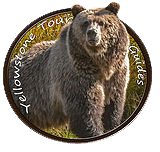Yellowstone in Spring – Tips and Activities

Yellowstone Park is one of the most spectacular places on Earth, and springtime is an especially special time to visit. If you’re planning a trip to Yellowstone in the spring, you should know that it can be quite busy. But there are still plenty of things to do and see in the park in the springtime, if you take some time out from your busy schedule to explore. Here are a few tips from our Yellowstone tour guides to help you plan your visit to Yellowstone in the spring.
Get Up Early
If you’re planning to visit Yellowstone Park in the spring, it’s important to get up early. This is the best time to see wildlife, steam from hydrothermal features and be in the right place for Old Faithful to erupt. You’ll also have fewer people around to disturb the quietness of the park and limit your risk for hypothermia. However, you’ll need to pack a little extra warm clothing for April as the temperature can dip below freezing during the day and rain can quickly turn into ice on roads overnight. If you’re interested in seeing wildlife, head to Lamar Valley in April to watch bison calve and black bears emerge from their dens. You’ll also see wolves, moose and elk in the area. Make sure to follow the park’s wildlife viewing guidelines and stay at least 100 yards away from any animal.
Hike
Spring is a great time to explore Yellowstone Park when it’s quiet and less crowded. You’ll have more time to get up close and personal with wildlife without crowds obstructing your view. It’s also an excellent time to take a Yellowstone backpacking day trip! Many of these are accessible and relatively easy, which means you don’t need to be an expert to enjoy them. In addition to enjoying the landscapes and waterfalls, you’ll likely be able to spot a variety of birds and animals as they start to return from their winter homes and migrate back into the park. Some of the most common reappearing species include sandhill cranes, mountain bluebirds and ospreys.
Go Wildlife Watching
Spring is an amazing time to visit Yellowstone Park, with wildlife in full bloom and birds reemerging from their winter hiding places. It’s also less crowded and offers an opportunity to hike in relative solitude. During this brief period, you can enjoy everything from wolf pack hunts to grizzly bear sightings to an abundance of bison and elk calves. As with all Yellowstone wildlife, be aware that animals are wild and unpredictable – always keep your distance. Use binoculars or a telephoto lens to get a better view of animals and back away slowly whenever an animal approaches you. Besides the wildlife, spring is a great time to explore thermal features like geysers and hot springs. The steam that rises and gathers during these times makes them particularly exciting to watch.
Check Out The Old Faithful
If you are visiting Yellowstone Park in the spring, don’t miss seeing the world’s most famous geyser: Old Faithful. This gushing spout of superheated water has fascinated millions of visitors for over 150 years, and it’s a must-see on every trip to the park. The first geyser named in the park, Old Faithful erupts at regular intervals and is the most predictable geyser in the Upper Geyser Basin. You can get an estimated eruption time online, and the rangers at the visitor center and at a Junior Ranger station will let you know if there’s a chance you can see it during your visit. To avoid the crowds, try to arrive early in the morning – ideally before 10 am, but getting here earlier is even better. Then, you can walk the boardwalk trails through the Upper Geyser Basin with far fewer people, and exit the park before it gets too crowded.
Don’t Overdo It
One of the most important things to remember when planning a visit to Yellowstone Park in the spring is to not overdo it. Over 4 million visitors come to Yellowstone each year, and it takes a lot of effort and resources to keep everyone safe while enjoying the park. You don’t want to risk falling in a hot spring or getting charged by a bison. This is a common occurrence, and it can lead to serious injury or even death. For this reason, we recommend exploring Yellowstone on foot, rather than driving around. This way you can get off the beaten path and really enjoy some of the lesser-known parts of the park! Contact us to start planning your next adventure now!
